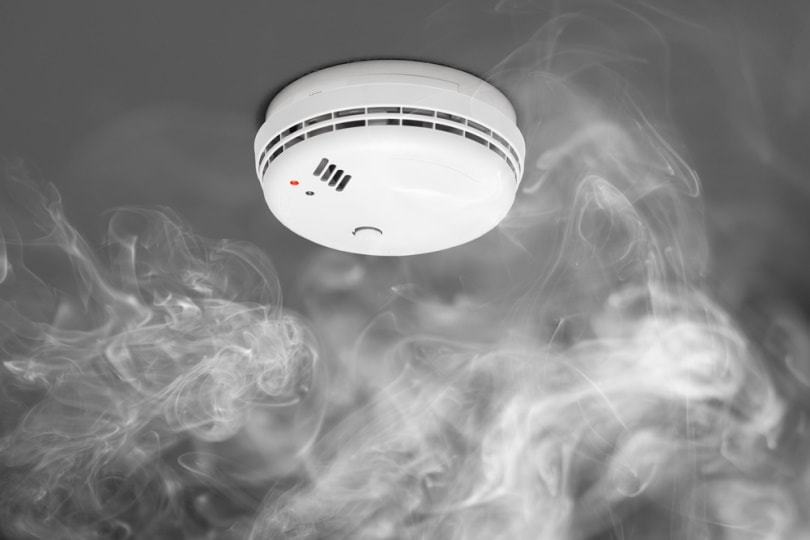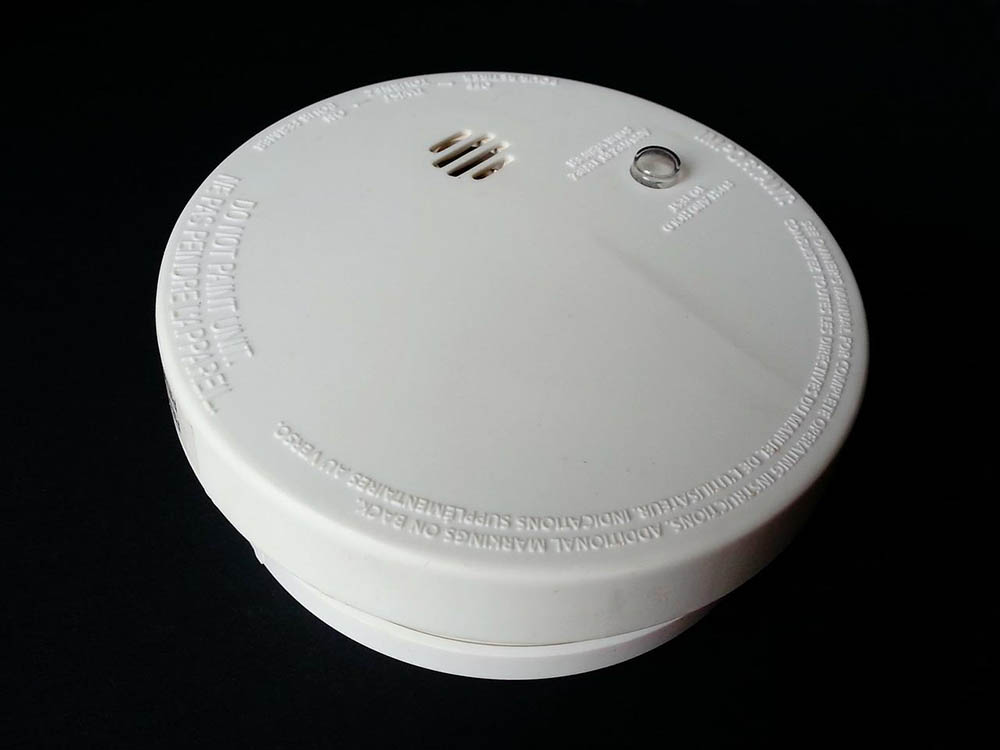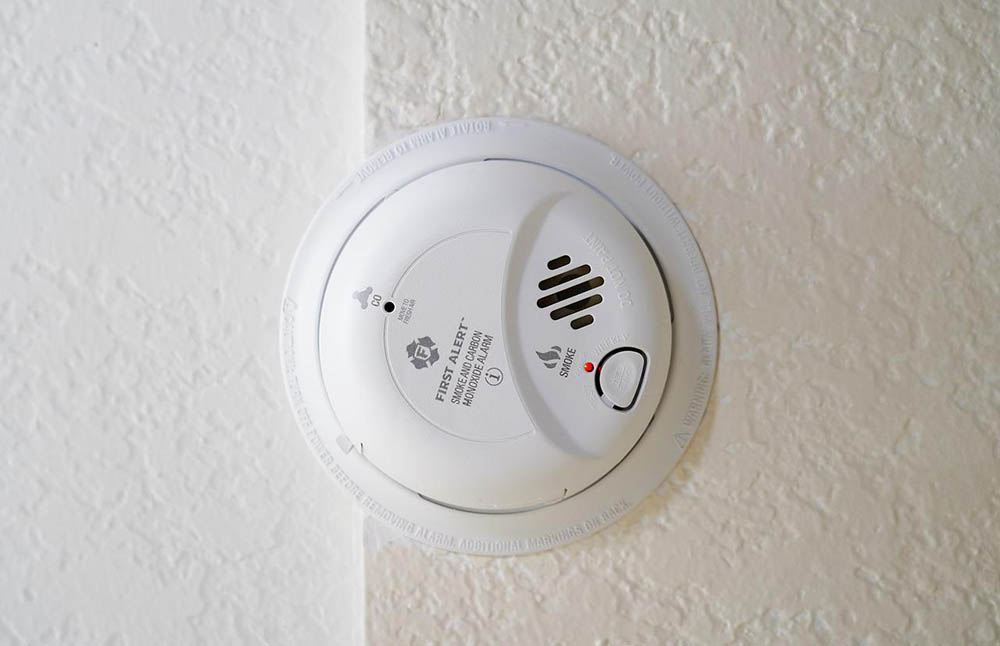Heat Detectors vs. Smoke Detectors: Differences, Types & FAQ
-

- Last updated:

Who knew the nation’s most common cause of house fires is cooking? According to the National Fire Protection Association, there are an average of 358,000 residential fires each year, further spurred by broken heating equipment and electrical malfunction. Every day seven people perish as a result of these fires.
Therefore, having a good fire detection system in place should be the first concern for landlords and homeowners. Smoke and heat detectors are the most typical design for these systems. Although these devices are manufactured to fulfill different needs, both types of detectors are capable of detecting a fire. Installing a fire detector in your residence or place of work may assist in keeping everyone, including tools and equipment, safe.
In this guide, we deep dive into the differences between smoke and heat detectors, how they work, and which will best serve you in safeguarding your home. Let’s take a look.
 Heat Detectors Overview
Heat Detectors Overview
A heat detector detects any abrupt temperature shift or unexpected heat buildup. It is a dependable tool essential for commercial and residential use. When a fire starts, the gadget reacts swiftly to the thermal energy it produces, suppressing the flames before they spread. It links to an alarm that warns occupants of the building.

The 2 Types of Heat Detectors
Heat detectors come in two types: fixed temperature and rate of rise heat detectors. Both monitor temperature changes in the vicinity of the alarms. Each of them employs a unique technique to achieve the same end effect—an alarm.
1. Fixed Temperature Heat Detectors
A fixed temperature heat detector senses the room’s temperature and sounds when it rises above a specified point. The typical trigger temperature for these heat detectors is 58°C.
The working concept uses a bimetallic switch element made of two different metals, one of which has a greater thermal coefficient of expansion than the other. When a fire occurs, the metal with a higher coefficient heats up and expands at a specific temperature limit. This causes the switch to flex and close the circuit, activating the alarm.
2. Rate of Rise Heat Detectors(ROR)

Rate of rise heat detectors measures the temperature change rate. They come with two thermal sensors (thermocouples or thermistors), one of which detects heat from convection or radiation and the other of which measures the room’s ambient temperature. The alarm goes off if the first one warms up faster than the second one by at least 6.7° to 8.3°C per minute.
What Situations Call For Heat Detectors?
Heat detectors are typically installed in storage spaces where chemicals or fuels are maintained since these are the sites where intense heat and high flames are most likely to occur. The kitchen, indoor garage, and laundry room are also areas that call for heat detectors. Heat detectors are ideal in these places over smoke alarms since the gasses emitted by the installed equipment would cause false alerts. Additionally, heat detectors are suitable in rooms with high ceilings.
Pros and Cons of Heat Detectors
Heat detectors work best in fires with tall flames, high temperatures, and minimal early smoke. Additionally, heat detectors offer a more accurate fire detection method in polluted or dusty areas where smoke detectors are susceptible to false alarms. They are also frequently employed to activate sprinkler systems due to their lower rate of false alarms compared to smoke detectors.
While fixed-temperature heat detectors normally respond to most flames, they exhibit thermal lag when fires intensify rapidly. Thermal lag happens when a heat detector alarms at a temperature greater than its set point due to rapid temperature rises. As such, it may require the installation of a rate of rise heat detector alongside it which can incur unnecessary costs.
Alternately, the rate of rising heat might cause false alerts if the installation environment or your residential region naturally experiences sharp fluctuations in the ambient temperature.
However, heat detectors are ineffective in fires that produce a lot of smoke and very little initial heat, such as damp or smoldering flames.

Smoke Detectors Overview
A smoke detector is an instrument that detects thick smoke in the area where it is mounted. It is a priceless tool for spotting fire dangers in the house and protecting your family as it alerts to an unusually high level of smoke in the vicinity. This aids in lowering the risks of the fire spreading and endangering individuals.
The 3 Types of Smoke Detectors
Smoke detectors come in three main types that incorporate different technologies. They react to the presence of smoke in distinct ways:
1. Ionization Smoke Detectors

More blazing flames trigger a response from this kind of smoke detector. The gadget employs ionized particles to ionize the air and measure the difference when smoke is present. The smoke detector features two openings, one of which lets outside air in and the other of which is sealed. Then, both chambers emit some radioactive particles to ionize the air.
The gadget detects smoke when the air feels different and the current between the two chambers isn’t steady. When smoke disrupts the current, the alarm goes off.
2. Photoelectric Smoke Detectors
Photoelectric smoke detectors utilize LED lights to detect smoke. The device has a chamber that houses the LED light. It has a sensor located at the other end of the chamber where the LED light streams through. The gadget detects smoke when it enters because smoke scatters light beams. It is very effective since it reacts to smoke 15–20 minutes more quickly than other devices and in its ability to detect smoldering flames.
3. Dual Sensor Smoke Detectors

Dual sensor smoke detectors combine both ionization and photoelectric technologies into one device. Together, the sensors provide your house with complete smoke and fire detection. The dual sensor smoke detector may assist in giving the earliest possible warning regardless of the kind of fire.
Where Are Smoke Detectors Ideal?
Your home should have smoke alarms on every level, including the basement and attic, installed to provide the utmost level of safety. It is beneficial to install smoke alarms in every space, including hallways, landings, and bedrooms, for optimal safety.
Avoid installing a smoke detector in areas where food is cooked since they are sensitive to very small amounts of smoke. Kitchens and garages, for instance, may set off false alarms because of the smoke particles discharged.
Pros & Cons of Smoke Detectors
Smoke detectors are faster in detecting possible fires than heat detectors. This is the main benefit smoke detectors have over heat detectors. Some flames do not burn quickly, so by the time the temperature has climbed high enough to set off a heat alarm, the simmering fire may have produced enough smoke to endanger people. Smoke detectors are therefore, an essential component of your fire detection system in situations when human lives are at stake.
Additionally, smoke detectors offer constant protection regardless of where you are. You may feel secure knowing you are protected when you have the support of a dependable smoke detector.
However, smoke detectors have a significant flaw. They are prone to false alarms. Environmental elements like dust, steam, or smoke that isn’t the result of a fire, such as smoke from cigarettes, can set off smoke detector alarms.
Insects and fine dust particles may have an impact on a fire alarm’s sensors. Therefore, they require routine maintenance to ensure that there is no space for error which might be a fairly expensive undertaking.
Finally, the alarm’s power supply is also a concern. Because the alarm is powered by mains power, it will also stop working if the power goes out.
Is It Ideal to Install Both Heat and Smoke Detectors?
Heat detectors may be a dependable and essentially trouble-free choice when protecting property is the main goal. Most people prefer heat detectors due to their inexpensive cost, and increased resistance to pollutants and adverse environmental conditions. In other instances, the heat detectors are utilized to activate fire suppression equipment like fire sprinklers.
Modern smoke detectors are made to withstand greater concentrations of airborne pollutants and a wider range of temperatures. Despite being more expensive than heat detectors, these solutions react significantly faster. Advanced smoke detectors frequently enable first responders to handle the fire threat before significant property damage occurs, allowing building occupants additional time to react.
It’s also crucial to remember that laws governing fire alarms differ from nation to nation and frequently change. Some may require at least one of the two to be present in your home or workplace. For instance, Scotland just enacted new legislation that all homeowners must adhere to.
 Conclusion
Conclusion
To be honest, there is no right answer. Like heat detectors, smoke detectors have advantages and disadvantages of their own. In the end, it comes down to various circumstances that need to be appropriately considered.
When deciding whether to install heat detectors or smoke detectors, you must consider the purpose of the space, the risk of injury to people, and the area where you will install the detectors. It would be best to consider the likelihood that the area may experience many false alarms. Both will frequently need to be included in your fire alarm system at various locations throughout the property. However, a qualified fire safety expert will tell you which would best suit your home or business.
See Also:
- https://www.safeopedia.com/definition/1080/smoke-detector
- https://www.sciencedirect.com/topics/engineering/heat-detector
- https://www.nfpa.org/News-and-Research/Data-research-and-tools/Building-and-Life-Safety/Home-Structure-Fires
- https://www.gov.scot/publications/fire-and-smoke-alarms-in-scottish-homes/
Featured Image Credit: New Africa, Shutterstock
Contents
 Heat Detectors Overview
Heat Detectors Overview